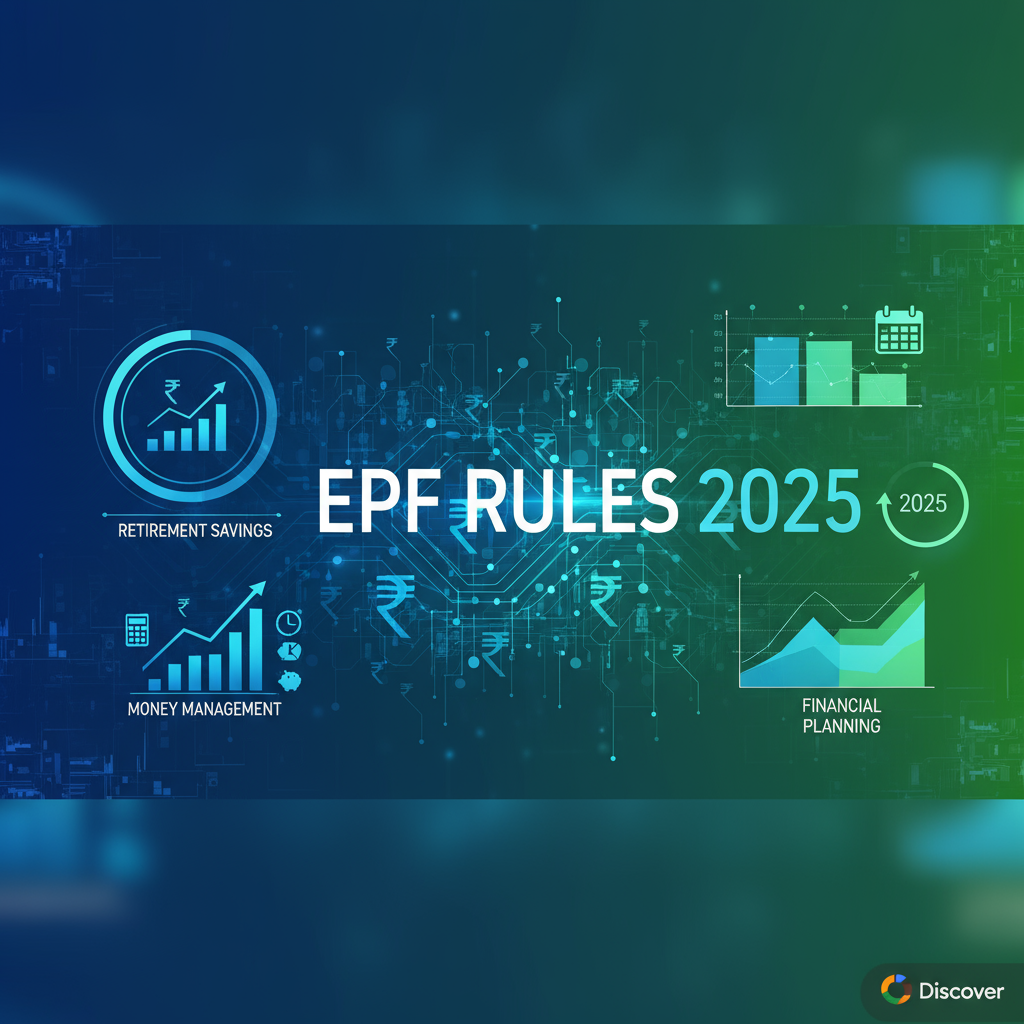EPF Withdrawal Rules 2025: New Policies, Changes, and Complete Guide for Employees
Published: October 28, 2025
Category: Finance News
Tags: EPF Withdrawal, Employee Provident Fund, EPFO Rules 2025, Financial Planning
Major EPF Policy Changes 2025: New Withdrawal Rules Impacting Millions of Employees
Financial Policy Update: The Employees’ Provident Fund Organisation (EPFO) has implemented significant withdrawal rule changes in 2025, creating both opportunities and challenges for India’s working population. These policy shifts are addressing the “mushrooming members, weakening fund growth” conundrum while providing enhanced flexibility for fund access.
New EPF Withdrawal Rules 2025: What’s Changed
Key Policy Changes Implemented:
Enhanced Withdrawal Flexibility:
– Simplified withdrawal process for medical emergencies
– Reduced documentation requirements
– Faster processing times (reduced from 20 to 10 days)
– Online withdrawal portal improvements
– Mobile app withdrawal facility expansion
Modified Withdrawal Limits:
– Partial withdrawal limits increased
– Age-based withdrawal options expanded
– Category-specific withdrawal allowances
– Emergency withdrawal provisions
Understanding the EPFO Conundrum
The Growing Membership vs. Fund Growth Challenge:
Membership Statistics:
– Current Members: Crores of employees enrolled
– Growth Rate: Year-over-year increase patterns
– Contributions: Total monthly inflow analysis
– Withdrawal Trends: Increased early withdrawals
Fund Growth Analysis:
– Total Corpus: Current EPFO fund size
– Investment Returns: Performance metrics
– Administrative Costs: Operational expenses
– Sustainability Concerns: Long-term fund health
Complete Guide to EPF Withdrawal Types
Types of EPF Withdrawals Allowed:
1. Partial Withdrawal (Premature)
– Eligibility: After 5 years of service
– Maximum Limit: Up to 50% of employee contribution
– Purpose-Based Limits:
– Medical treatment: Up to 6 times monthly salary
– Home loan: Up to 90% of accumulated balance
– Marriage: Up to 50% of employer’s contribution
– Education: 50% of total contribution
2. Full Withdrawal
– Eligibility: Upon retirement or unemployment
– Conditions:
– Retirement at 58 years
– Unemployment for 2 months
– Medical incapacitation
– International employment
3. Emergency Withdrawal
– Medical Emergencies: Immediate access for critical treatments
– Natural Disasters: Calamity relief provisions
– Financial Crisis: Unemployment or bankruptcy situations
New 2025 Withdrawal Rules: Detailed Breakdown
Age-Based Withdrawal Options:
Below 54 Years:
– Partial withdrawal only (no full withdrawal)
– 50% contribution withdrawal after 5 years
– Emergency withdrawal provisions
– No tax implications for partial withdrawal
54-57 Years:
– Partial withdrawal allowed
– 50% withdrawal permitted
– Enhanced emergency access
– Partial tax considerations
Above 58 Years:
– Full withdrawal eligibility
– Reduced tax withholding
– Additional withdrawal options
– Pension scheme options
Step-by-Step Withdrawal Process
Digital Withdrawal Process:
Step 1: Log into EPFO Portal
– Visit epfo.gov.in
– Register/Login with UAN
– Verify personal details
– Check withdrawal eligibility
Step 2: Choose Withdrawal Type
– Select withdrawal category
– Enter withdrawal amount
– Specify withdrawal reason
– Add supporting documents
Step 3: Document Upload
– Upload required documents
– Verify document clarity
– Ensure file size compliance
– Submit application
Step 4: Employer Verification
– Employer receives notification
– Verification process initiated
– Approval workflow completion
– Status tracking available
Step 5: Fund Transfer
– Amount credited to bank account
– Processing time: 10-15 days
– SMS/Email notifications
– Transaction confirmation
Required Documentation for EPF Withdrawal
General Documents:
– Universal Account Number (UAN)
– Aadhar Card (mandatory linking)
– Bank Account Details (cancelled cheque)
– PAN Card (for high-value withdrawals)
Specific Withdrawal Documents:
Medical Withdrawal:
– Medical certificate from registered doctor
– Hospital admission letter
– Treatment bills and invoices
– Medical prescription
Home Loan Withdrawal:
– Bank loan sanction letter
– Property registration documents
– Construction approval (if applicable)
– Bank loan agreement copy
Marriage Withdrawal:
– Wedding invitation card
– Expense receipts/bills
– Family relationship proof
– Bank account details
Tax Implications on EPF Withdrawals
Tax-Free Withdrawal Conditions:
– Service Duration: 5+ years of continuous service
– Tax Implications: No tax on withdrawal amount
– Pension Contributions: 3.16% on basic salary exempt
– Employer Contributions: Tax-free withdrawal
Taxable Withdrawal Scenarios:
– Early Withdrawal: Service less than 5 years
– Tax Rate: Income tax slabs applicable
– TDS Deduction: 10% for withdrawals above ₹50,000
– Form 16/16A: TDS certificates for filing
International Employment:
– Tax Considerations: Double taxation avoidance
– Country-specific rules: International tax implications
– Treaty benefits: India-Specific country agreements
– Expert consultation: Recommended for complex cases
Digital Transformation in EPF Services
Online Services Enhancement:
UAN Portal Features:
– Universal Account Number management
– Member profile updates
– KYC verification status
– Service history tracking
Mobile App Benefits:
– One-touch withdrawal requests
– Real-time status updates
– Document upload facility
– Direct bank integration
SMS and Email Services:
– Withdrawal status notifications
– Account balance alerts
– Interest credit notifications
– Scheme update alerts
EPF vs. PPF: Investment Comparison
EPF Advantages:
– Employer Contribution: 12% of basic salary
– Tax Benefits: Section 80C limits
– Interest Rates: Government-guaranteed returns
– Liquidity: Partial withdrawal options
PPF Comparison:
– Investment Control: Individual account management
– Withdrawal Flexibility: More restricted access
– Interest Rates: Currently competitive with EPF
– Tax Benefits: Section 80C with EEE benefits
Retirement Planning with EPF
Strategic EPF Management:
Long-term Growth Strategy:
– Compound Interest Benefit: 15+ year accumulation
– Interest Optimization: Early contribution starts
– Regular Monitoring: Annual fund performance review
– Investment Allocation: Within EPF corpus management
Retirement Corpus Planning:
– Target Amount: Calculate based on lifestyle needs
– Years to Retirement: Plan withdrawal timing
– Tax Optimization: Efficient withdrawal strategies
– Multiple Income Sources: EPF as primary/secondary support
EPF Investment Strategy 2025
Maximizing EPF Returns:
Contribution Optimization:
– Voluntary Contributions: Increase employee share
– Tax Benefits: Maximize Section 80C utilization
– Regular Contributions: Maintain consistency
– Interest Rate Monitoring: Track performance
Withdrawal Timing Strategy:
– Retirement Planning: Age-based withdrawal strategies
– Tax Efficiency: Optimize tax implications
– Market Conditions: Consider economic factors
– Personal Circumstances: Adapt to life changes
Common Withdrawal Mistakes to Avoid
Critical Errors to Prevent:
Documentation Mistakes:
– Incomplete Documents: Missing required papers
– Incorrect Information: Typographical errors
– Expired Documents: Outdated certificates
– Unclear Scans: Poor document quality
Process Errors:
– Wrong Withdrawal Type: Selecting incorrect category
– Insufficient Balance: Overestimating available amount
– Duplicate Applications: Multiple submission issues
– Communication Gaps: Not responding to EPFO queries
Timing Errors:
– Early Withdrawal: Losing long-term benefits
– Missed Deadlines: Late application submissions
– Tax Planning: Poor tax optimization timing
– Investment Timing: Market timing considerations
EPFO Scheme Updates and Notifications
Recent Scheme Modifications:
Interest Rate Changes:
– Current Rate: Government-declared rates
– Historical Comparison: Past performance analysis
– Future Projections: Expected rate trends
– Comparison with Other Schemes: Competitive analysis
Policy Updates:
– Digital Services: Enhanced online capabilities
– Withdrawal Rules: Simplified processes
– Coverage Expansion: Increased member benefits
– Administrative Improvements: Faster processing
EPF Withdrawal for Different Life Stages
Career Stage Planning:
Early Career (0-5 years):
– Focus: Emergency fund building
– Withdrawal Policy: Limited options available
– Strategy: Long-term accumulation mindset
– Financial Planning: Balance emergency needs vs. growth
Mid-Career (5-15 years):
– Flexibility: Partial withdrawal options
– Major Life Events: Marriage, home purchase, education
– Tax Planning: Optimize withdrawal timing
– Retirement Preparation: Increased contribution strategy
Senior Career (15+ years):
– Full Withdrawal: Available retirement options
– Pension Schemes: Annuity conversion options
– Tax Efficiency: Strategic withdrawal planning
– Wealth Transfer: Family financial planning
EPF and Financial Independence
Building Financial Security:
Emergency Fund Strategy:
– EPF Role: Part of emergency fund portfolio
– Access Provisions: Emergency withdrawal rules
– Balance: Liquidity vs. growth considerations
– Insurance Integration: Life insurance coordination
Retirement Independence:
– EPF Contribution: Primary retirement pillar
– Supplementary Sources: PPF, NPS, other investments
– Withdrawal Strategy: Sustainable income planning
– Inflation Protection: Real return considerations
SEO Keywords: EPF withdrawal rules 2025, EPFO new policy, employee provident fund, EPF withdrawal process, financial planning
Meta Description: Complete guide to EPF withdrawal rules 2025. New policies, digital withdrawal process, tax implications, and retirement planning strategies for employees.





